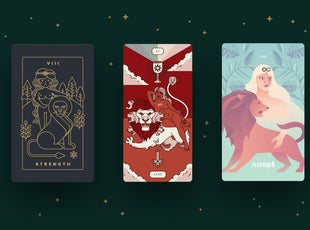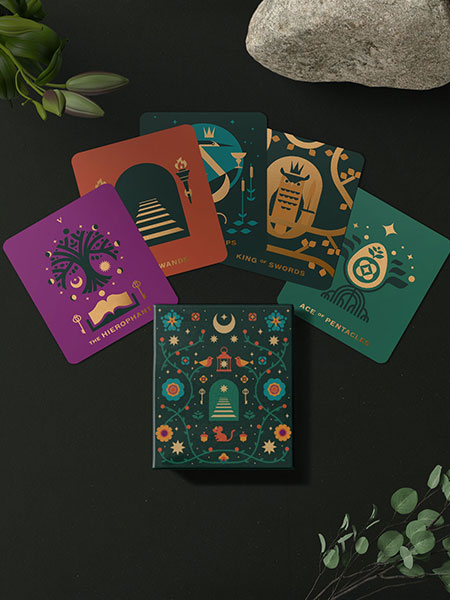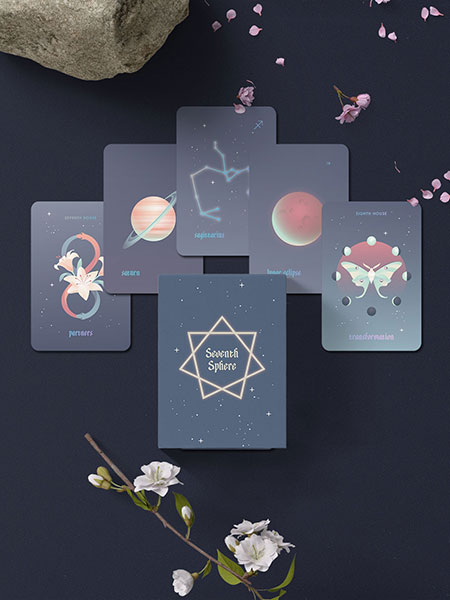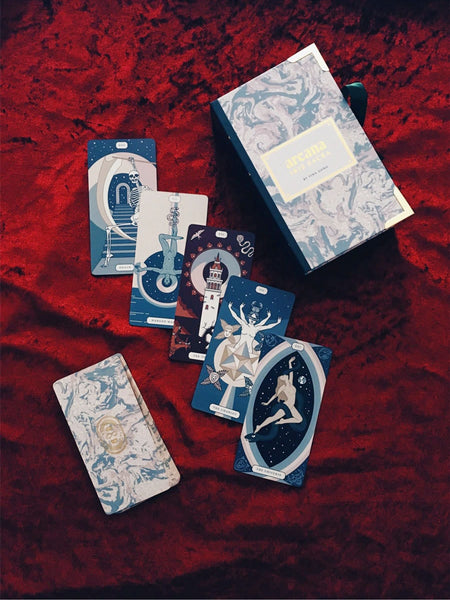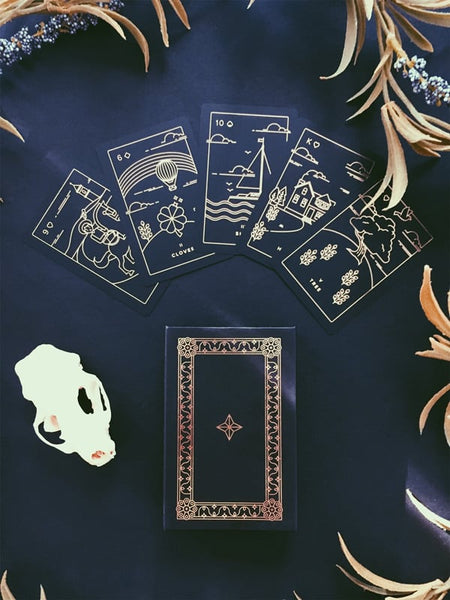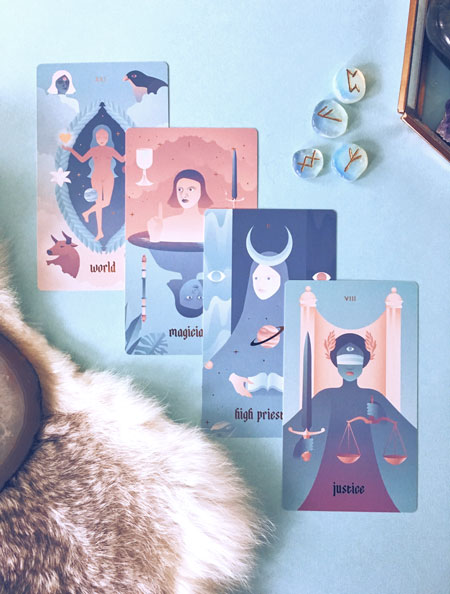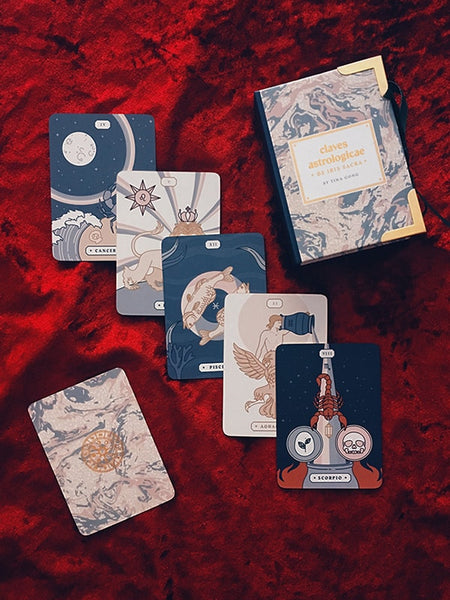✦ ✦ ✦
Tarot Elements: Correspondences and Working with Elemental Dignities
Published
Within the Tarot, the minor arcana is composed of 4 suits, each with their own elemental correspondences. These elemental associations are great in giving you a general feeling about each of the minor arcana cards, while also acting as examples for how these elemental energies can appear in your daily life. You can also use the elements to get an overarching perspective of what your readings main themes are. An abundance of cups can signal that relationships and emotions are at the core of your reading, swords can signal that matters of conflict and intellect are playing a big role.
Polarities in Tarot Elements
You’ll also see a note in these summaries about polarities, which are if an element is active or passive (sometimes called receptive). These play a strong role in how the elements interact with one another. You’ll see these concepts referenced in astrology as well. Active and passive polarities are part of a greater and balanced whole, and they both have their own strengths and weaknesses.
| Active | Passive |
| changes one’s environment | adapts to environment |
| focuses energy outward | focuses energy inward |
| direct | indirect |
| extroverted | introverted |
| active | reactive |
I’ve written a lot about each of the elements on their own separate page, but here is a summary of each suit.
| Suit | Element | Polarity | Keywords |
| Wands | Fire | Active | Action, inspiration, drive, willpower, passion, ambition |
| Cups | Water | Passive | Emotion, feelings, intuition, relationships |
| Swords | Air | Active | Logic, ideas, intellect, communication |
| Pentacles | Earth | Passive | Nature, body, material world, stability |
Alongside this basic understanding of the elements within tarot, the way that elements interact can also affect how we read the cards. These rules of how elements affect one another are called elemental dignities. If you’ve ever worked with a Thoth style tarot deck, you can see how these elements interact within the court cards, where each court card is made of up two elements. How the elements relate to each other also have an effect on that card’s meaning. Outside of the court cards, you can apply your knowledge of elements within a reading as well; two fire or wands cards fuel each other’s strengths - they can burn through anything that stands in their way, but can be difficult to control.

Tarot Elements: Rules for Elemental Dignities
The following are the rules you’ll need to know for each of the element interactions. Later in the article, we’ll go through each of these rules step by step, combination by combination. There are a total of 16 combinations in all.
- If they are the same suit, they strengthen each other
- Fire and Air are active, they support each other
- Water and Earth are passive, they support each other
- Fire and Water are enemies, they weaken each other
- Air and Earth are enemies, they weaken each other
- Fire and Earth are neutral to each other
- Water and Air are neutral to each other
As you can see, there are 4 different types of relationships, which break down into the following:
- Strengthen: Increases the intensity of the elements. It amplifies both their positive and negative qualities.
- Support: These elements have a collaborative relationship. They build one another up.
- Weaken: These elements cancel each other out. They decrease the effectiveness of each element.
- Neutral: They don't affect one another.

Tarot Elements and Combinations
The following are some descriptions of what these elemental combinations can look like. Some of these you’ll notice are repetitive, but it’s because there can be some very slight variations for which is the more dominant element in the pair. In the following notation, the first element is the dominant, with the second being supporting. If you find this too much, the basic reading without weighting being given to dominant and supporting elements can still be helpful in giving you additional layers of meaning. Consider the following as a completionist’s guide on each of the combinations.
Fire Tarot Element Combinations
Fire / Fire - Strengthens
This combination is all action and ruthless intensity. Extremely powerful drive. Like other combinations of the same element, both its strengths and weaknesses are amplified. This powerful energy can be constructive and destructive; it can push you forward through many obstacles, but also leave a trail of destruction in its wake.
Fire / Water - Weakens
Opposing elements mean that they weaken each other. Fire’s drive and motivation is cancelled out by water’s emotions. Imagine having big ambitions and goals but being weighed down by fears.
Fire / Air - Supportive
This combination works well together, like oxygen fueling a burning flame. Air’s intellect and quick thinking can support fire’s goals, pushing it forward quickly. New ideas can make one’s aspirations bigger and grander.
Fire / Earth - Neutral
Usually considered neutral. Earth can bring some stability and practicality to fire’s flames and push it towards its goal. If there’s too much of earth however, it can snuff the fire out. Big plans for the future can either be manifested step by step with some practicality, but making a stark realization of your reality can also make a dream dissipate.
Featured Product
Arcana Iris Sacra Tarot Deck
Featured Product
Arcana Iris Sacra Tarot Deck
$55.00 USD
Water Tarot Element Combinations
Water / Fire - Weakens
Water’s calming emotional energy is broken by the urgency of fire. Sometimes this can be helpful in bringing water to action, but most of the time, it feels intrusive and perhaps coercive. Deep reluctance can be inferred.
Water / Water - Strengthens
Deeply emotional and spiritual energy, but also perhaps disconnected from the real world. Imagine being lost in one’s daydreams; perhaps trapped even. There’s the sense that much beauty, intuition and creativity is in this world, but inability to make any changes in reality.
Water / Air - Neutral
They represent the heart and the mind; they can work together well if they are balanced, but they can also conflict with one another. There’s the potential for a lot of confusion and pain when we try to reason through our sometimes irrational feelings.
Water / Earth - Supportive
Supportive combination where earth gives some shape and foundation for water’s meandering ways. Earth’s reliable and steady nature gives a sense of comfort here, when emotions may be running wild.
Join 2 million+ users
Looking for more insight into your relationship?
Download App
Air Tarot Element Combinations
Air / Fire - Supportive
Fire brings enthusiasm and drive to a well thought out plan created by air’s intellect and communicative ability. Thoughts and ideas are being propelled forward with fire’s inspiration, lighting a spark that leads to creative action.
Air / Water - Neutral
Water brings some tenderness to an otherwise very stark and controlling element. Air’s talent for communication can be driven by water’s emotions; expression of feelings can lead to powerful changes in this combination.
Air / Air - Strengthens
Powerful but can be destructive. Air unleashed can be unstable and disconnected from reality. Sometimes this element combination can indicate cruelty and ruthlessness, but in a colder, more strategic expression than say, the double fire combination.
Air / Earth - Weakens
Ineffective combination. While earth attempts to give some stability to air, it fails to work on an overactive mind. Air fails to be moved, contained or changed by earth. Imagine someone who fails to accept a reality check.
Earth Tarot Element Combinations
Earth / Fire - Neutral
Earth provides stabilizing and lush environment for fire’s spark of creativity. It can counterbalance some of fire’s intensity. Imagine a dream coming to fruition with slow and steady infusions of enthusiasm and energy. Fire can also burn earth down, but it renews and refreshes earth’s fertility anew.
Earth / Water - Supportive
Peace and satisfaction are suggested by this combination. Both elements are passive, so not much is going on, but water brings a tranquil enjoyment to earth. Imagine the satisfaction that comes from seeing the fruits of one’s work or what they have.
Earth / Air - Weakens
These elements don’t get along; air attempts to bring lightness to heavy earth, but earth is unmoved, and instead drags air down. Air also brings a certain disdain for the materiality of earth, or a sense of feeling imprisoned by one’s material constraints.
Earth / Earth - Strengthens
All earthy qualities are enhanced; both its solid reliability, strength and stability - but also its inability to be moved. Can be presented as a stubborn obstacle, like a mountain, or an anchor that can both steady you and restrict you.
Tarot Elements and Polarities Summary Infographic

Tarot Elements Summary Infographic


